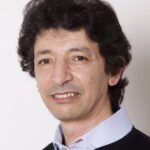Lien vers Pubmed [PMID] – 14578428
Invest Ophthalmol Vis Sci 2003 Nov; 44(11): 5006-15
Human Usher syndrome is the most common form of combined deafness and blindness. Usher type I (USH1), the most severe form, is characterized by profound congenital deafness, constant vestibular dysfunction, and prepubertal onset retinitis pigmentosa. Previous studies have shown that the USH1-proteins myosin VIIa, harmonin, and cadherin 23 interact and form a functional network during hair cell differentiation in the inner ear. The purpose of the present study was to analyze the molecular and cellular functions of these USH1 proteins in the mammalian retina.Antibodies to USH1 proteins were generated and used in Western blot analysis of subcellular photoreceptor fractions and immunofluorescence and electron microscopy of the retina.Splice variants of harmonin were differentially expressed in the photoreceptor cell compartments. Whereas harmonin b isoforms were restricted to the light-sensitive outer segment, the harmonin a and c isoforms were more ubiquitously distributed in the photoreceptors. At the synaptic terminal of photoreceptor cells, harmonin a and c colocalized with myosin VIIa and cadherin 23.USH1 molecules can assemble to a supramolecular complex at photoreceptor synapses. Such a complex may contribute to the cortical cytoskeletal matrices of the pre- and postsynaptic regions, which are thought to play a fundamental role in the organization of synaptic junctions. Dysfunction of any of the USH1 complex partners may lead to synaptic dysfunction causing retinitis pigmentosa, the clinical phenotype in the retina of patients with USH1. Furthermore, in photoreceptor outer segments, harmonin may also contribute to the clustering of outer segment proteins into supramolecular complexes.

